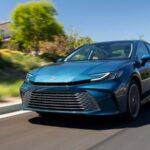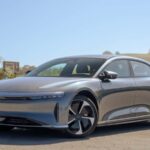Subtle tweaks have turned the Miata from overly whimsical to one of the world’s great sports cars.
No, there isn’t more power. And there certainly isn’t more weight. What Mazda did to the 2024 MX-5 Miata was a bunch of thankless, non-flashy updates that most folks will dismiss on the ND’s 10th year of production. Hell, they didn’t even change the bumpers for this final facelift—just some new headlights and taillights.
Instead, Mazda went to town developing a new limited-slip differential with more-favorable locking and unlocking rates, and took an opportunity to re-engineer and recalibrate the electronic power steering system. Things that, to the casual driver, wouldn’t make a difference. But it made all of the difference. It’s the shit driving nerds stay up late at night thinking about, some of those nerds just happen to work at Mazda R&D.
I, Hardtop Sports Car Man, can put my hand up and say that the subtly updated and retuned 2024 Mazda MX-5 is the sports car I always dreamed the Miata should be. No more overly whimsical, rolly-polly, soft-suspension imprecision. With just the simple reengineering of several small parts, the ND3 is an entirely different car to drive.
| Quick Specs | 2024 Mazda MX-5 Miata |
| Engine | 2.0-liter lnline-four |
| Output | 181 Horsepower / 151 Pound-Feet |
| Curb weight | 2,341 Pounds |
| Price | $30,150 ($38,450 As-Tested) |
Dave Coleman is tall. Much taller than the ND Miata could ever normally accommodate. But as a lifelong Miata enthusiast, he’s always made do with his taller-than-6-foot frame, wedging snugly into the ND for his development miles with the car. Formerly the technical editor of Sport Compact Car, a purveyor of countless shitbox adventures, a 987 Cayman S and Hayabusa-swapped NA Miata owner, and a true lover of driving, you really couldn’t pick anyone better for the title of Vehicle Dynamics Manager for all of Mazda’s cars.
Though he will rarely take credit for anything relating to the handling brilliance of Mazda’s current lineup, there’s one thing I know about Coleman: He is a steering snob of the highest order. His benchmark for steering is the Lotus Elise. He knows good steering, possibly better than anyone in the business. He also understands it isn’t a simple matter of calibration, but of physical engineering in the steering rack, suspension, drivetrain—basically everything.
While running through the changes, he impressed the smallness of them upon me. A tweak here, an opportunity to optimize there. Nothing major was changed, and in fact, it was an unforeseen opportunity. One of the world’s biggest suppliers of electric motors for power steering systems changed a magnetic part within their motors, completely changing their behavior. Thus, Mazda was forced to recalibrate the steering, a chance Coleman and his team seized the opportunity with both hands. With that, they also took an opportunity to reduce friction in the steering system, something he sees as the enemy of good steering.
Then they took a look at another often forgotten but hugely influential component of handling: The differential. Most folks think, “open diff bad and limited-slip good.” On a general level this is correct. But the setup of a diff can influence everything about how a car handles, whether it understeers or oversteers at any phase of the corner. Look at the latest Porsche 911 GT3RS’s driver-adjustable differential settings as an example. A more-locked diff on deceleration means more understeer because the rear wheels are dragging together at the same speed, encouraging the car to keep traveling straight. The opposite is true for acceleration. A locked diff forces the outer and inner tires to spin at the same rate, increasing stability under straight-line acceleration, while allowing the driver to comfortably and predictably induce rotation on corner exit.
For the ND3, Mazda developed a new cam mechanism that allows for different ramp angles on acceleration and deceleration–Basically, how and when the diff locks and unlocks. It still uses the same novel conical clutch design, but to address the strange handling of the ND1 and ND2, Mazda increased diff lock during deceleration and reduced locking on acceleration. Folks familiar with the previous cars will know it was particularly eager on turn-in and was happy to slide. Depending on the aggression of your inputs, it could get uncontrolled, partially a symptom of its soft suspension and roll characteristics, so the ND always took a level of precision and respect to drive.
Mazda aimed directly at this complaint with the new diff. A small, extremely nerdy change. Like the rest of the ND, it’s worth noting that these changes go against everything the contemporary car business does. They didn’t make the diff electronic, nor did they widen the Miata’s tires. I don’t think they ever even considered adding more horsepower. These changes don’t show up on a spec sheet. But on a sunny, top-down drive through the northern end of Los Angeles County, I may as well have been driving an entirely new Miata.
It took all of 300 feet to realize that Coleman hit a home run with the new steering calibration. It was simply delicious and blindingly different to before; weighty on center, with none of the wandering strangeness of the ND2. Overall steering effort is significantly increased, but the true marker of steering brilliance is weight buildup off-center and feedback once you’re stuck into the corner. The signs were promising, with even a simple left turn through an intersection demonstrating the Miata’s EPAS mastery—A linear buildup of weight that is perfectly assisted. It’s not so assisted that it feels artificial, nor is it a heavy butter-churner that some automakers prefer in lieu of actually understanding what steering feel should be. It feels simply like manual steering rack with less weight. And, to be fair, less road texture.
Ascending into the well-traveled curves of the Angeles National Forest, the steering remained incredible and more. Thanks to low-grip Bridgestone Turanza all-season tires (the same spec as before) the limit was low enough to feel the full range of steering feedback. While there wasn’t much high-frequency granularity, the important stuff was there. The wheel broadcasts every step along the approach to the limits of traction, with the steering reaching a perfectly round peak of effort just as the front tires reached their limit. Just beyond the limit, the steering would lighten slightly and flatten in effort, clearly communicating exactly how the tires wanted to be driven.
Bumps and undulations came with requisite increases and decreases in weight, a rare phenomenon for electronic power steering. Even with a cheeky lift and provocation into a slide, the steering wheel would beautifully chase the front tires. Yaw was clearly communicated with a twofold stream of information, the rear axle joining the steering conversation with more global suggestions, once the car began rotating. Completing the experience was an astutely judged steering ratio, where a deft driver can simply suggest the Miata into a curve and hold it near-center, only adjusting in fine motions to add more or less yaw to the car.
That new rear differential, while perhaps less obvious to most than the steering retune, also plays a huge part in this overall sporting picture. It’s tuned in such a way that instead of the ND2’s eager turn-in, the ND3 can be guided to the apex with supreme stability, but without the sensation of understeer. It’s night and day more buttoned down in the area it suffered most. With 181 horsepower, the more unlocked diff on acceleration is an almost imperceptible difference—the Miata never had an issue beyond the apex to my hands and ass. It almost certainly feels like the dampers were retuned to match, something Mazda wouldn’t confirm or deny to me, but my butt dyno is certainly suspicious.
It feels masterful, a level even beyond Porsche’s benchmark work in the Porsche 718 Cayman. Yeah, a journalist spending three paragraphs waxing lyrical about steering and handling–I’d be rolling my eyes too. But the difference from the ND2 is enough to make the Miata driving experience almost fundamentally different as a sports car. Where a stock Miata almost couldn’t be taken seriously as a precision instrument, the ND3 is now right there with a Subaru BRZ or a Porsche Cayman. I also love that Mazda didn’t fall prey to the light-steering-equals-light-car trap that befalls so many of the modern heavyweights. Steering is the heart and soul of any sports car.
The magic is that it doesn’t lose a bit of its Miataness. It’s still fun above all else, a car that is meant to put a smile on your face. It still has a lovely, zingy engine and gearbox. It still weighs less than 2,500 lbs with a single human in it. It hasn’t lost its whimsy or its charm. And even though I was done with the “work” of filming and photographing the car about an hour into a 5-hour long press drive, I didn’t stop driving until the sun went down and the gas gauge read empty.
That is the mark of something spectacular.
Competitors
- Subaru BRZ
- Toyota GR86
Get the best news, reviews, columns, and more delivered straight to your inbox. Sign Up Today
2024 Mazda MX-5 Miata
Engine 2.0-Liter Four-Cylinder
Output 181 Horsepower / 151 Pound-Feet
Transmission Six-Speed Manual
Drive Type Rear-Wheel Drive
Weight 2,341 Pounds
Efficiency 26 MPG City / 35 Highway / 29 Combined
Seating Capacity 2
Cargo Volume 5.0 Cubic Feet
On Sale Now
Base Price $28,985
As-Tested Price $38,450



